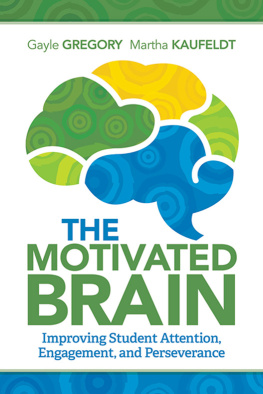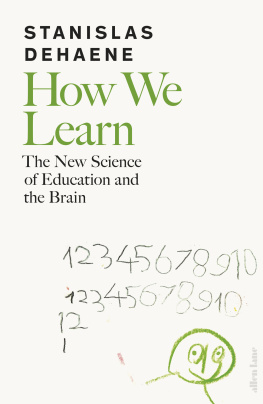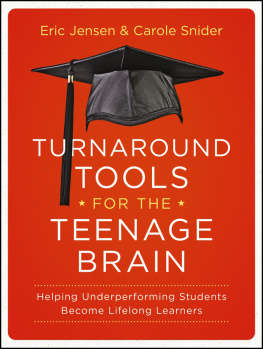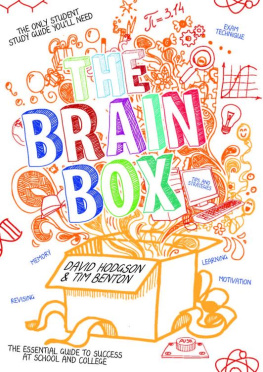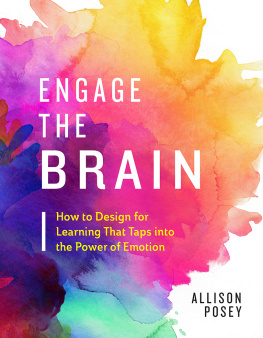Foreword
....................
Perspectives on Our Emotional Nature and Implications for Educational Advances
Gregory and Kaufeldt superbly summarize the implication of our ever-increasing scientific understanding about our fundamental emotional nature on the development of better educational practices. The affective neuroscientific understanding of animal emotionality has helped illuminate some of the greatest mysteries of human existencethe basic psychological forces that motivate people, both young and old, to behave in characteristic ways (Panksepp, 1998; Panksepp & Biven, 2012). Indeed, our personality structures reflect the strengths and weaknesses of our various affective strengths and weakness, mental powers that we share in kind, if not precise detail, with other mammals. In medicine we have learned the underlying principles by which human bodies operate through detailed studies of animal bodies. In education, the neuroscientific understanding of our affective minds will help inform and refine our instructional practices. Furthering that understanding is the great achievement of this book.
Our brains' basic affective functions"evolutionary memories"enhance our capacity to anticipate survival issues. Through learning, our brains promote knowledge of the world. It is important for educators to understand such foundations of human minds, and how they can inform development of new educational practices.
The fundamental importance of our children's affective lives is superbly illuminated in this book. Surprisingly, this possibility has emerged substantially because of our increasing knowledge about the minds of other animals, especially the diverse attentional, emotional, and motivational systems that constitute the core of organismic psychological coherence. As we better appreciate the emotional "tools for living" built into all mammalian brains, we can enhance educational experiences for all children. We must obviously minimize the negative affective forces of FEAR (anxiety), RAGE (anger), and PANIC (separation-distress/psychological-pain/loneliness systems), but with that work done, we must amplify the diverse intellectual riches that only a full engagement of the SEEKING system can providethe massive emotional-motivational system that supports our urges to PLAY with and CARE for others, not to mention the turmoil of LUST emerging in adolescence. An understanding of these systems tells us much about where we should be going in our educational processes. This book clarifies important dimensions of human existence, while drawing out didactic implications.
Thus, this text offers a clear understanding of our emotional nature and how that beneficially affects educational practices. It is among the first to consider the spectra of wisdom emerging from ongoing neuroscientific inquiries: we are born emotional creatures. Child-rearing practices that respect this are already providing superlative guidelines for improving child development (Sunderland, 2006).
This book introduces educators to our fundamental emotional processes that come at various levels of complexity within the bottom-up hierarchical structures of mental development, that eventually, with normal maturation and education, allow children healthy top-down regulation of their urges. Among the brain's emotional networks, the SEEKING systemlong inappropriately called "The Brain Reward System" (in fact, there are many rewarding systems in the brain)is the one that deserves the greatest emphasis in education. Being the foundation for healthy exploration, with feelings of enthusiasm and curiosity, understanding this system is critical for students to become active learners.
Because it mediates so many important functions of the braincontributing critically to CARE, LUST, and PLAYthe SEEKING system facilitates both the enthusiasm for and reinforcement of learning. At the most basic level, this system promotes finding all things in the world needed for survival. Its fundamental nature (prior to learning) is to project children into the world as enthusiastic activists who can look after their own welfareexpertly harvesting both nuts and knowledge, so to speak. This remarkable system, always at the ready most of our waking moments (and super-active also during our dreams that help consolidate life-supporting strategies), is the focus of this book. If we can encourage children to be active seekers of knowledge, many of our educational efforts will have lasting positive consequences for structuring each child's world and future success.
How we do this remains more of an art than a science, but Gregory and Kaufeldt's superb guidelines can enhance success. They provide guidelines for implementing the SEEKING system within our educational practices. The book covers general principles that need to be understood, recommendations for specific practices, and suggestions for implementing these practices. They bring educators a new level of scientific sophistication for discussing the many issues that need to be considered for educational practices to be harmonized with the natural functions of the brain. These are beyond accepted standard-bearers of learning and memorythose who understood the importance of reinforcement contingencieswhich had great impact on educational practices during the 20th century.
In 1930, one of the fathers of behaviorism, John Watson, wrote "Give me a dozen healthy infants, well-formed, and my own specified world to bring them up in and I'll guarantee to take any one at random and train him to become any type of specialist I might selectdoctor, lawyer, artist, merchant-chief and, yes, even beggar-man and thief, regardless of his talents, penchants, tendencies, abilities, vocations, and race of his ancestors" (Watson, 1930, p. 82). His compatriot, B.F. Skinner, gave us automatic learning machines where rapid reinforcement of correct answers clearly sped up learning. The ingredient that both missed was any discussion of how we help create internally motivated, enthusiastic, active learners. That is what a fuller consideration of the SEEKING system in education provides and what this book offers. The book speaks clearly and effectively about how we can recruit the affective emotional-mental resources that all children share to help facilitate the growth of upper-minds with active engagement and with new information and perspectives. Superb teachers implicitly understand such issues, but this book makes many of the issues explicit.
A secondary theme developed by the authors is the benefit that we can achieve by recruiting the powers of PLAY for our educational ends. This primal emotional system that our group first started to study in animal models in the late 1970s has entranced us more than any other, especially as the child-rearing, educational implications became ever clearer for me (Panksepp, Siviy, & Normansell, 1984). This system, which relies heavily on the SEEKING system (as do LUST and CARE), is also subcortically situated in very ancient brain regions. Indeed, our main empirical measure of social joy"rat laughter" that can be evoked by systematically ticklingmaps along the SEEKING system. In every place in the brain where we can evoke such playful sounds with deep brain stimulation, we have found the sites to be rewarding (Burgdorf et al., 2007), which is our main factual evidence for positive feelings in nonspeaking animals.
PLAY arousal appears to be the fundamental source of social joy, which, just like the enthusiasm of the SEEKING system, is at a low ebb in clinical depression (Panksepp et al., 2014). Once we realized that this ancient brain function is elaborated by brain systems below the neocortex, we started to consider how it might affect child-development, especially if young children were deprived of having adequate avenues to express this system each and every day (Panksepp & Scott, 2013). We suspected that deprivation could lead to various Attention Deficit Hyperactivity Disorders (Panksepp 1998). Indeed, to our surprise, all medications typically used to treat ADHD, such as methylphenidate, were strong reducers of play in young animals. Why would psychostimulants reduce psychologically robust behavior such as PLAY? We still don't quite understand the details, but we must be worried about children in the classroom who have not had their fair share of the satisfactions of physical play. Our animal work indicates that abundant play sets in motion many brain systems that not only facilitate learning but promote happiness (Burgdorf et al., 2011). The many benefits of play should alert educators to the problems that may emerge when children are deprived of this vital resource for mental health. Without a regular diet of fun social engagements, children become hungry for play and begin to "act out," potentially disrupting the flow of classroom instructional activities.

